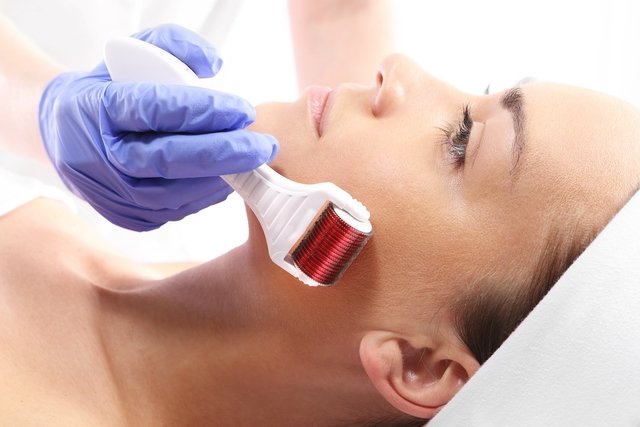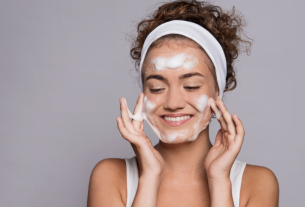Microneedling is an aesthetic treatment that uses very fine micro-needles that stimulate the formation of new collagen fibers, and is recommended for removing acne scars, softening stretch marks, eliminating wrinkles, reducing sagging skin and preventing hair loss.
This type of treatment, also known as percutaneous needle collagen induction (IPCA), can be performed with a manual device called Dermaroller or an automatic device called DermaPen, and the use of an anesthetic ointment is recommended before starting the procedure, to reduce the discomfort.
The use of the microneedling device is individual and can be done at home or in an aesthetic clinic, by a dermatologist or a qualified professional, and it is important to pay attention to skin cleansing and care after the procedure, to avoid irritation or the emergence of new ones. scars.

What is it for
Aesthetic treatment with microneedling can be indicated for:
- Skin rejuvenation;
- Eliminate scars caused by acne or burns;
- Reduce enlarged pores on the face;
- Combat wrinkles and sagging skin;
- Reduce expression lines, especially those around the eyes;
- Lighten skin blemishes or melasma;
- Hyperhidrosis.
Microneedling can also be used to help treat alopecia, which is characterized by the rapid and sudden loss of hair from the scalp or other areas of the body. See how alopecia is treated.
How it works
Microneedling works by stimulating the production of collagen and elastin by the skin, through the application of devices that contain micro-needles that penetrate evenly into the dermis, which is the layer of tissue that lies between the surface of the skin and the layer of fat.
These small needles cause a controlled injury to the skin, favoring its remodeling and skin thickening.
Additionally, microneedling for alopecia helps promote the dilation of blood vessels, improve local blood circulation and the formation of new vessels, release growth factors, and increase the expression of proteins, which stimulate hair growth.
How to prepare
Preparation for microneedling generally begins 30 days before the procedure, with the doctor recommending the application of specific creams or products, containing vitamin A or C, to stimulate collagen production by the skin.
Furthermore, when consulting a doctor, one should inform them if the person has any type of allergy to medications, as an anesthetic ointment is used on the skin before starting microneedling.
It is also important to inform your doctor of all medications, supplements or vitamins that you take frequently, so that they can check whether they will increase the risk of bleeding or interfere with skin healing.
Make an appointment with your nearest dermatologist, using the tool below, for more guidance on preparation and how microneedling is performed:
Taking care of your health has never been easier!
How is done
Microneedling is done with devices that contain multiple very small and very thin needles, passed over the skin to be treated, by the dermatologist, in specialized clinics. To perform microneedling, the doctor must follow some steps such as:
- Clean the skin to be treated with antiseptic solutions;
- Apply a local anesthetic ointmentsuch as lidocaine or prilocaine (Emla), throughout the region to be treated;
- Wait 15 to 45 minutes until the local anesthetic exerts its effect;
- Remove the anesthetic from the skinwith sterile gauze and saline solution;
- Stretch or lengthen the skin with one handand use the other to apply the microneedling device;
- Using the dermaroller device on your skin, passing the roller in horizontal, vertical or diagonal movements. When using the DermaPen automatic pen, the device is slid over the skin, in a direction perpendicular to the stretching of the skin.
Generally, microneedling lasts 15 to 20 minutes, and after finishing microneedling, the doctor must apply saline compresses to the treated skin.
Does microneedling hurt?
Microneedling can cause pain or discomfort during the procedure, which is why anesthetic ointments are used in the area of skin to be treated.
In some cases, when the doctor uses longer needles to perform microneedling, it may be necessary to perform the procedure in a hospital environment and use general anesthesia or sedation, in order to avoid pain or discomfort.
Care after microneedling
It is normal for the skin to be red and sensitive after microneedling, so it is essential to always keep the skin clean and hydrated.
In the first 24 hours after microneedling, it is not recommended to use makeup or sunscreen, as the product can irritate the skin. The ideal is also not to expose the treated area to the sun and, only on the second day, start applying daily sunscreen to avoid staining the skin. Furthermore, you should avoid applying chemicals for 30 days after the procedure.
Types of microneedling
The type of microneedling varies according to the device, the main ones being:
- Manual device or dermaroller: it is a roller, with fine needles, usually 0.3 or 0.5 mm;
- Microneedling Pen or DermaPen: It is a device that resembles a pen, with microneedles of 0.3 to 3 mm at the tip.
In addition, there is also robotic microneedling or fractional radiofrequency microneedling, which is done with the microneedling device coupled to a radiofrequency device, which allows the effect of the treatment to be enhanced. Understand what radio frequency is.
How to use the dermaroller at home
The steps to use the dermaroller at home are:
- Wash the skin with cold water and neutral soap;
- Apply a good layer of anesthetic ointment, which contains lidocaine, for example, and leave it to act for 30-40 minutes;
- Completely remove the anesthetic from the skin with cotton wool and cold water or saline solution;
- Pass the roller over the entire face, 5 times horizontally, 5 times vertically and 5 times diagonally, (15 – 20 times in total) over each region. On the face, you can start with the forehead, then the chin and finally, as it is more sensitive, apply it to the cheeks and the area close to the eyes;
- After using the roller all over your face, you must clean your face again, with cotton wool and saline solution;
- Next, apply the product best suited to your skin type, such as hyaluronic acid, for example, and leave it to act until completely absorbed.
To perform microneedling at home, you must use a Dermaroller device, which has 0.3 or 0.5 mm needles. This type of device is normally used on the face, as larger needles are needed on the body, which should only be used by professionals.
See in the video below all the precautions you should take when doing microneedling at home:
When not to do microneedling
Microneedling is contraindicated in the following situations:
- Very active acne with pimples and blackheads present;
- Cold sore infection;
- I use anticoagulant medications such as heparin or aspirin;
- History of allergies to local anesthetic ointments;
- Uncontrolled diabetes mellitus;
- Treatment with radiotherapy or chemotherapy;
- Autoimmune diseases, such as lupus or rheumatoid arthritis;
- Skin cancer.
In these situations, it is not recommended to carry out this type of treatment without first consulting a dermatologist.

Sign up for our newsletter and stay up to date with exclusive news
that can transform your routine!
Warning: Undefined array key "title" in /home/storelat/public_html/wp-content/plugins/link-whisper-premium/templates/frontend/related-posts.php on line 12
Warning: Undefined array key "title_tag" in /home/storelat/public_html/wp-content/plugins/link-whisper-premium/templates/frontend/related-posts.php on line 13



